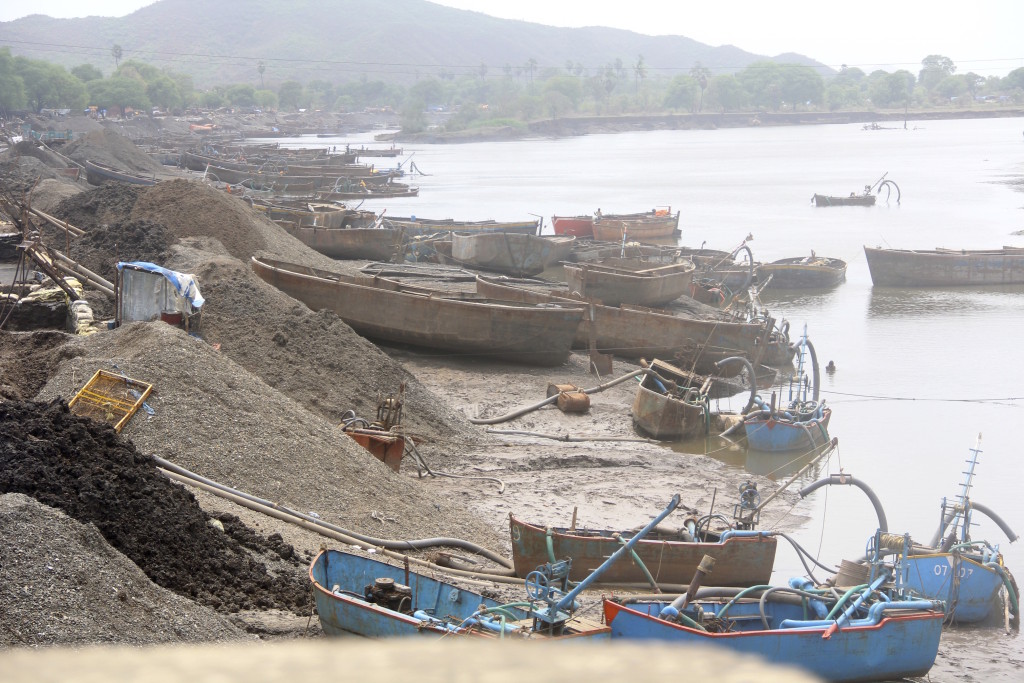It all starts as mountain rock.
That rock erodes from wind and rain and time, getting transported down rivers all the way to the sea, where it accretes onto beaches and into other sediments. That is the origin story of sand. Once that sand is on a beach, or off the coast, or on an inland shore, it is transported through a natural cycle that replenishes the resource over geologic time.
Or rather, that is the way it is supposed to work.

Sand mining has changed the natural cycle in a way that could have long-term, irreversible consequences if it is not managed properly. To conceptualize the issue, it is helpful to think of two different uses for sand: you can use it, or you can move it.
Using it includes in concrete (where it is a primary component in almost all major construction around the world) and in hydraulic fracturing (where it is used as a proppant to hold open fissures during well stimulation). Moving it includes beach nourishment, shoreline protection, barrier island construction, and dredging. In total, more than 40 billion tons are mined annually, more than any other natural resource.
Perhaps most worryingly, people rarely talk about sand. As a consequence, the environmental, economic, and social impacts of sand mining are in danger of falling through the cracks.
On Monday, August 8, I was on the Diane Rehm Show on NPR to discuss the global sand crisis. It was an informative glance into some of the key issues surrounding sand in the United States and around the world. You can stream or download a recording here.
Internationally, sand is a resource that some people deem worth killing for. In countries like India and Vietnam, “sand mafias” illegally mine sand, fueling rapid growth in construction (through concrete) while also claiming hundreds of lives a year as collateral damage. Fellow panelist Vince Beiser wrote a wonderful article on the subject in Wired in 2015. His reporting—and his partnership with ELI on a recent webinar—has spurred a burgeoning interest in the human rights abuses and environmental harm from sand mining on the international level.
Domestically, sand mining is characterized by uncertainty that must be urgently addressed to avoid lasting harm to our coasts. The uncertainty prevails at three different levels: environmental, scientific, and legal/regulatory. Environmentally, there is not yet a full accounting of how sand mining affects resources at the borrow site (where it comes from) and at the placement site (where it is going). Moving sand can be catastrophic for an ecosystem, and we are only beginning to understand how those ecosystem impacts unfold over time.
Scientifically, sediment transport is a difficult field, and we can never be sure where a sand grain will go when left to its own devices. Notoriously, upon hearing that his son Hans was to study sediment transport, Albert Einstein cautioned him against working in the field—he deemed it too complicated. Projects that rely on sediment transport—like beach nourishment—face massive scientific uncertainty.
Finally, the law and policy of sand mining is in flux. There are many cooks in the regulatory kitchen—from federal agencies like BOEM, EPA, the Corps, NMFS, and FWS, to state governments and state agencies, to local governments. The requirements are potentially undermined by their complexity. In the face of law and policy uncertainty, a holistic look at sand mining is needed to move forward in a more comprehensive (and safe) way.
And this is no idle issue that can be put off into the future. All along the U.S. coast, sand is being mined to the point of complete resource depletion in some areas. Along the Gulf Coast, states are fighting back against sea-level rise by pumping millions of tons of sand from the ocean depths to form new barrier islands. At the New Jersey shore, billions of dollars of coastal development are dependent on a narrow strip of man-made sandy beach that could be wiped out in the next storm. And even in Wisconsin, sand strip mining for hydraulic fracturing is denuding land while possibly causing major health impacts from airborne silica. Sand mining is an issue everywhere, but almost nowhere is it being discussed in the same way as other major mining practices.
In sum, from a domestic perspective, the sexy phrase of the day needs to be “cumulative impacts.” We must figure out how to consider all of the uses of sand together in a way that properly quantifies the impacts on the resource, on coastal communities, and on the environment. That work has yet to be done, and that is where ELI hopes to make a difference.
At the end of the one-hour-long show, Diane Rehm asked Vince Beiser about his takeaways on the subject. In addition to his insightful commentary about considering sand globally and domestically in the same way we consider other natural resources like oil, Vince left the audience with an important concluding thought.
“I’m constantly shocked by how little attention [sand mining] gets. . . .”
“Fortunately, groups like the Environmental Law Institute are getting involved.”
